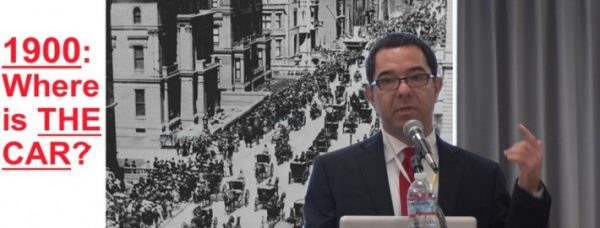
Tony Seba says private car ownership will be dead by 2030. Experts say more like 2050 or 2060, but change is coming
Suddenly, Tony Seba is the talk of the town. The Stanford lecturer released a study in early May predicting a new electric vehicles (EVs) business model – Transportation as a Service (TaaS) – would transform global auto manufacturing and destroy Big Oil in just 13 years. In this interview, the second part of three, Seba explains some of the technical changes that led to his bold predictions.
For some experts, Seba’s forecast is too bold. For instance, Dr. Fred Beach of the Energy Institute at the University of Texas Austin thinks Seba’s math is “solid,” but a timeline of 2050 or 2060 is more realistic.
Donate now! Please support quality journalism by contributing to our Patreon campaign. Even $5 a month helps us continue delivering high quality news and analysis about Canadian and American energy stories that affect your life and your lifestyle.
In the first interview, I pointed out some of the adoption accelerators – such as relieving traffic congestion in mega-cities like Vancouver and Los Angeles or helping meet governments’ greenhouse gas reduction commitments – that would drive rapid diffusion of TaaS.
“We completely agree that the autonomous electric vehicle is going to have a really significant impact on not only just the automotive industry, but what we might now call the mobility industry,” says EV analyst Chris Robinson with Lux Research.
But there are also significant adoption constraints.

“One is the assumption that there will be enough autonomous electric vehicles produced to meet this need,” Robinson said in an interview.
“The automotive industry is designing vehicles more than 10 years into the future right now. It’s going to be really challenging for them to start producing and making vehicles in the time frame that this report discusses.”
But the more important constraint will be the immaturity of autonomous vehicle technology, says Robinson.
“If you’re talking about TaaS, you need a fully autonomous vehicle. Not something like the autopilot from Tesla,” he said.
“You need full point A to point B autonomy and my colleagues on the autonomous systems team at Lux think in an optimistic scenario, we could see full autonomy emerge between 2025 and 2030. They call that their optimistic scenario simply because the challenges of ‘last mile transport’ are so radically different than something like a highway capable autonomy system, where you have very controlled expected environments.”
Beach, who describes himself as car guy and “gearhead,” says culture will be a big issue in Western countries that have over a century of experience with the automobile.

“We’ve been a car culture, a car society, a car persona for so many generations,” he said in an interview. “I use the fat, dumb, rich American example – there are a lot of us that own two, three, four cars in a household. Yeah, we get rid of one or two of them, but we’d still own a couple.”
Younger consumers, accustomed to digital technology and rapid change, will be prime candidates for TaaS, but older drivers and suburban families, for instance, will take much longer to adopt the new model.
“It will be a generational thing where I give up my driven-car when they pry my cold dead fingers off the steering wheel,” he said.
“But my kids may never own a car. That’s a generational thing and if a generation is 20 years, it may take a generation or two – 20 years plus another 20 years – it may take forty years for the kind of deep penetration that Tony’s talking about.”
Bottom line, while TaaS economics are compelling and provide a great deal of impetus to rapid change, there still plenty of constraints that will act as a drag on the process.
This interview has been lightly edited for clarity.
Seba: One of the key findings in our study is that the lifetime of an EV is 500,000 miles with very low operating and maintenance costs. Many automakers are working on million-mile vehicles. Modern internal combustion engine (ICE) cars last 140,000 miles (we used 200,000 miles, again, just to be conservative).

That’s important because in the individual model of ownership we use our cars 4% of the time and park it 96% of the time. In the TaaS model, companies would use their EVs 10 times as much, maybe more. Some companies are talking about 50% or 80% utilization.
Companies like Uber are already using their vehicles more than that. We used 40% in our study. At that utilization, TaaS companies can travel 10 times more miles each year. ICE cars would last just two years, but an EV would last five years.
Then we considered all the other costs, like insurance and maintenance, and the cost per mile to operate an EV at those utilization rates is a fraction of an ICE.
From day one, which we assume is 2021, TaaS can provide a cost-per-mile that is four to 10 times cheaper. The EV has a massive advantage over ICE.
Markham: This sounds like an “iPhone moment.” When Apple introduced the iPhone in 2007 – for, say, $600 – it was five to 10 times more expensive than a standard cell phone. But if that phone did six functions, the iPhone with apps could do, say, 6,000. And replace many devices, like watches and cameras. So, the value of the iPhone was huge compared to what came before. And within 10 years everyone had a smartphone. To date, six billion people use smartphones and in 2016 1.5 billion smartphones were sold globally.
Are we approaching an iPhone moment for transportation?
Seba: I use the iPhone model pretty consistently and the answer is, yes. But one of the things that made that rapid adoption easier was the business model innovation, which enabled consumers to lease the phone for two years and only pay $40 or $50 a month. That made it easier for people to adopt an expensive iPhone. This is a business model disruption, not just a technology disruption – it’s not just lower costs that’s going to make this happen.
Markham: Do you see the TaaS model disrupting transportation first in the congested mega-cities: Vancouver, San Francisco, LA, New York, Houston, Singapore, etc.?
Seba: Yes, initial adoption of TaaS is going to happen in highly-dense cities with high real estate prices. We actually modelled people’s opportunity costs, where we calculated the cost of wasting an hour, two hours commuting, when you could be making money. In my case, I could convert my downstairs garage and rent the suite to a student and increase my income.
When you include opportunity costs in the model, the TaaS adoption is even faster.
By the way, the transition has already started. In 2015 in New York City, there were already 500,000 ride hailing trips everyday. And that demand is growing by triple digits. That’s an indication of the demand that exists already in highly dense mega-cities,
Take Uber, which is already working on autonomous technologies because they understand the value that this is going to have to them in lowering the costs by five times. And Uber has already started incentivizing some drivers to go electric. That’s already happening. But the key thing is autonomous driving technology.
But we also modelled a lot of combinations of ICE versus EV versus autonomous versus non-autonomous.
One of the scenarios we modelled was: What if automakers like Mercedes or GMs go to market with the ride hailing plus autonomous driving plus ICE cars? One or two automakers will probably try that, right? Could they compete against companies using self-driving EVs?
The answer is, no. The economics just don’t work for TaaS using ICE vehicles.


2 Trackbacks / Pingbacks